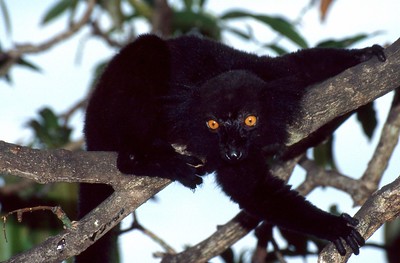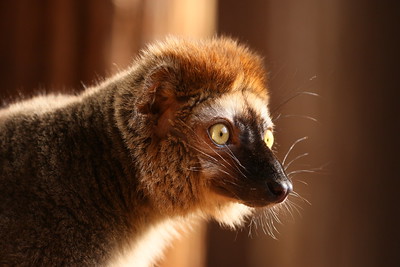When Lemurs Get High... or Do They?
Some primates, such as the black lemur (Eulemur macaco) or red-fronted lemur (Eulemur rufifrons) of Madagascar, look for arthropods that contain certain favorable toxins. To get to them, these primates bite or shake the poor creatures, which then excrete the substances in self-defense.
Black lemurs have have been found looking for millipedes (Charactopygus sp.). When they do, lemurs cautiously bite them so that the millipedes start secreting a liquid. The chemicals they excrete (including cyanide or chlorine among others) are not dangerous to the lemurs. Benzoquinones, which they also contain serve as a repellent to deter annoying parasites when rubbed into their fur, and it is known to kill insects as well. Lemurs salivate and rub the liquid mix and the millipedes themselves all over their body ferociously.
And they just 👏 can't 👏 seem 👏 to 👏 get 👏 enough 👏 of 👏
When they swallow or sniff the liquid, they visibly enter a state that we'd call 'high'. The lemurs continuously bite and hit the up-to-one-foot long millipedes to get more and more... possibly more than they'd need to rub into their fur.
The question still is whether they enjoy it. Is it possible that this state they enter is clearly just the inevitable effect of those heavy chemicals, and that they move so frantically as they rub the chemicals in their fur just to get over and done with it quickly?
We'd need more research to know for sure. We'd think they wouldn't do it if it made them feel bad, but sometimes the downsides are outweighed by the overall benefit.
Now red-fronted lemurs seem to do the same, but they prefer millipedes of another genus - Sechelleptus. These millipides, nonethless, also produce benzoquinones. It gets a bit more deep with these lemurs, however, as they are known to suffer from many intestinal parasites. They quite probably use these millipedes to self-anoint. If that's true, they can join the club with capuchin monkeys (Cebus and Sapajus spp.) who are known to self-anoint with various plants such as onions, limes and some herbs, but also millipedes, and are also involved in mutial (or social) anointing.
Whether or not the lemurs truly enjoy the state they enter as they rub the millipede cocktail into their fur, the results are clear: fewer problems with parasites, and, though possibly stressed almost to death, sometimes even the millipedes survive.
Sidenote: Please, don't try this - (sadly) you're not a lemur.

Photo credit: Bernard Dupont
| Common name: | Black lemur |
| Scientific name: | Eulemur macaco |
| Phylum: | Chordata |
| Class: | Mammalia |
| Order: | Primates |
| Family: | Lemuridae |
| IUCN status: | Vulnerable |
| Population trend: | Decreasing |
| Scientific reading: |

Photo credit: zoofanatic
| Common name: | Red-fronted lemur |
| Scientific name: | Eulemur rufifrons |
| Phylum: | Chordata |
| Class: | Mammalia |
| Order: | Primates |
| Family: | Lemuridae |
| IUCN status: | Near threatened |
| Population trend: | Decreasing |
| Scientific reading: |
